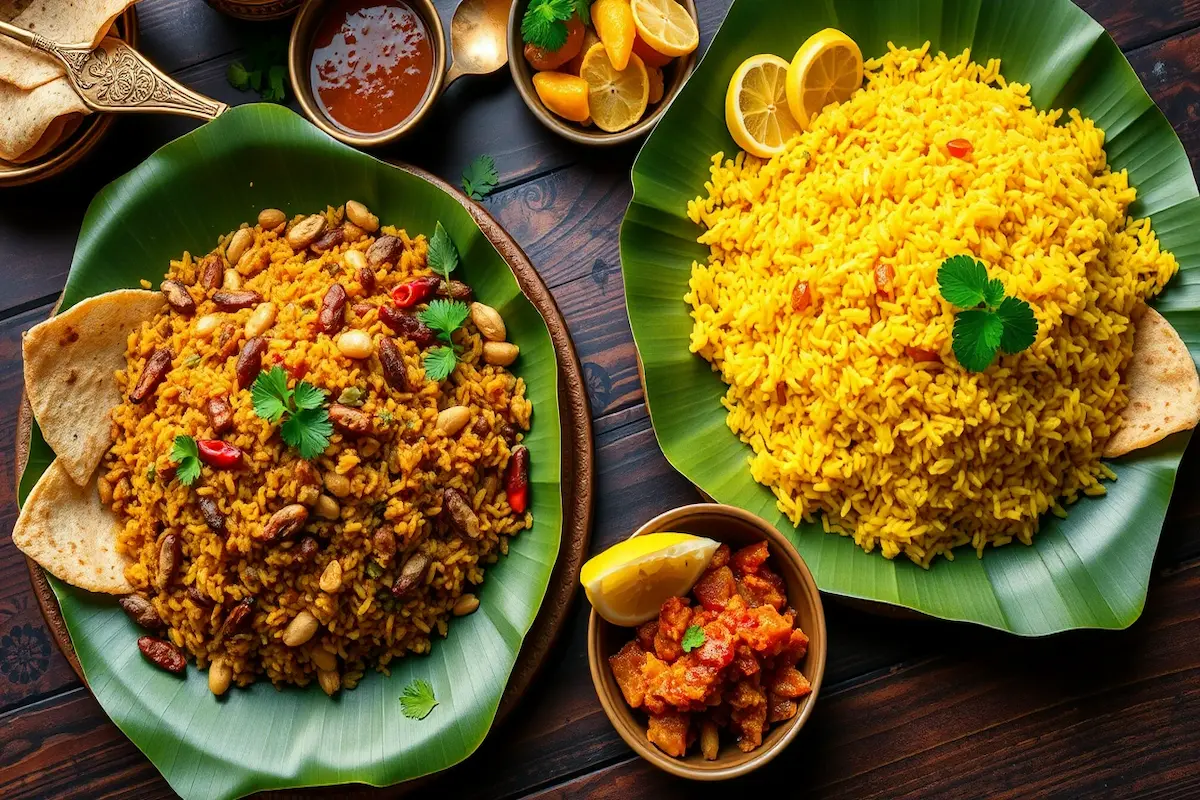Introduction
Tamarind rice and lemon rice are not just beloved staples of South Indian cuisine—they are also a reflection of the region’s rich culinary heritage. These dishes, which are celebrated for their vibrant flavors, hold a special place in both everyday meals and festive occasions. Therefore, understanding their preparation offers not only a culinary experience but also a deeper appreciation of South Indian culture.
Interestingly, while tamarind rice captivates with its earthy tanginess, lemon rice enchants with its refreshing citrusy flavor. Moreover, both recipes are incredibly versatile, making them suitable for a variety of preferences and occasions. Let’s dive into what makes these recipes so special and explore how to perfect them.
Tamarind Rice (Puliyodharai)
A Glimpse Into Its History and Origin
Tamarind rice, also known as Puliyodharai in Tamil, is one of South India’s most iconic dishes. It has a deep connection to temple traditions, where it is often prepared as prasadam (sacred offerings). Consequently, its tangy and complex flavors make it a favorite for festive celebrations and everyday meals alike.
Notably, the dish has evolved over time, with each South Indian region adding its unique touch. For instance, the Andhra Pradesh version, called Pulihora, is spicier, while Karnataka’s Puliyogare leans towards a slightly sweeter flavor. Regardless of the variation, tamarind rice remains a testament to the region’s love for bold and balanced flavors.
Ingredients and Their Significance
To make the perfect tamarind rice, it is important to understand the role of each ingredient:
- Rice: Short-grain varieties like Sona Masuri or Ponni are ideal since they absorb the flavors well.
- Tamarind: This tangy fruit pulp provides the signature sourness, making it an essential ingredient.
- Spices: Mustard seeds, fenugreek seeds, coriander, and dried red chilies create a complex flavor profile.
- Lentils: Split chickpeas (chana dal) and black gram lentils (urad dal) add a nutty texture.
- Peanuts: Roasted peanuts contribute both crunch and richness.
- Jaggery: This natural sweetener balances the tanginess, ensuring a harmonious flavor.
- Sesame Oil: Traditionally used, sesame oil adds an earthy aroma that enhances the dish.
Step-by-Step Preparation
To create this flavorful dish, follow these steps carefully:
- Prepare the Rice: Cook the rice until each grain is separate. Spread it out to cool, as this prevents clumping.
- Extract Tamarind Pulp: Soak tamarind in warm water for 20 minutes. Then, squeeze it to extract the pulp and strain it to remove any fibers.
- Roast and Grind Spices: Dry roast coriander seeds, fenugreek seeds, and dried red chilies. Once aromatic, grind them into a fine powder.
- Prepare the Tamarind Paste: Heat sesame oil in a pan and temper it with mustard seeds, curry leaves, lentils, and peanuts. Next, add the tamarind extract, turmeric, jaggery, and ground spices. Cook until the mixture thickens.
- Combine and Rest: Gently mix the paste with the cooled rice. Allow it to rest for at least 30 minutes so that the flavors can meld.
For a visual guide on how to prepare rice perfectly for dishes like this, refer to how to cook perfect rice.
Regional Variations
Certainly, one of the most fascinating aspects of tamarind rice is its regional diversity:
- Tamil Nadu: Kovil Puliyodharai, or temple-style tamarind rice, is made with gingelly oil and a unique spice blend.
- Andhra Pradesh: Known as Pulihora, this version includes green chilies for extra heat.
- Karnataka: Puliyogare often features grated coconut and jaggery for a sweeter finish.
Serving Suggestions
- Pair tamarind rice with crispy papadum or fried plantain chips for added crunch.
- Serve alongside a cooling cucumber raita to balance the tanginess.
- For extra variety, include a side of spicy mango or lime pickle.
Lemon Rice (Chitranna)
Cultural Context and Significance
If tamarind rice symbolizes depth and complexity, lemon rice represents simplicity and freshness. Commonly referred to as Chitranna in Kannada, this dish is celebrated for its vibrant yellow hue and zesty taste. Not only is it a popular choice for festivals, but it is also a go-to meal for travel, thanks to its long shelf life.
Essential Ingredients
Each ingredient in lemon rice plays a crucial role in crafting its flavor:
- Rice: Cooked short or medium-grain rice works best for absorbing the flavors.
- Lemon Juice: Freshly squeezed juice ensures the dish’s signature tang.
- Spices: Mustard seeds, turmeric powder, and green chilies add warmth and color.
- Curry Leaves: A staple in South Indian cooking, curry leaves enhance the dish’s aroma.
- Peanuts or Cashews: Roasted nuts bring both crunch and richness.
- Coriander Leaves: Fresh coriander adds a burst of herbal freshness.
How to Make Lemon Rice
For a perfect lemon rice, follow these simple steps:
- Cook and Cool the Rice: Ensure the rice is fluffy and cooled completely before use.
- Temper Spices: Heat oil in a pan, add mustard seeds, and let them crackle. Then, toss in green chilies, curry leaves, and roasted peanuts or cashews.
- Add Turmeric: Mix turmeric powder into the tempered spices, coating them evenly.
- Incorporate Lemon Juice: Turn off the heat before adding fresh lemon juice to preserve its vibrant flavor.
- Combine: Gently mix the tempered spices with the rice, ensuring even distribution.
Regional Twists
Lemon rice, though simple, has regional variations that make it even more interesting:
- Tamil Nadu: A straightforward version that highlights bold lemon flavors.
- Karnataka: Often sweeter, with the optional addition of grated coconut or jaggery.
- Andhra Pradesh: Spicier, with a liberal use of green chilies.
Serving Suggestions
- Enjoy lemon rice with spicy lime or mango pickle for a flavor contrast.
- Serve it alongside onion raita for a cooling accompaniment.
- Add crispy papad for a textural balance.
Tamarind vs. Lemon Rice: A Flavorful Comparison
Flavor Profiles
- Tamarind Rice: Bold and earthy, with layers of tangy, sweet, and spicy flavors.
- Lemon Rice: Light and refreshing, with a bright citrus tang.
Preparation Complexity
While tamarind rice involves making a concentrated paste, lemon rice is much simpler and quicker to prepare.
Tips for Success
- Always use fresh lemon juice for lemon rice to achieve the best flavor.
- For tamarind rice, ensure the tamarind paste is thick enough to coat the rice evenly.
- Let the rice cool completely before mixing to prevent clumping.
Conclusion
In conclusion, tamarind rice and lemon rice are more than just dishes; they are cultural icons that showcase South India’s culinary richness. By following these recipes, you can bring the vibrant flavors of South Indian kitchens to your table. Try them today, and you’ll understand why they remain timeless favorites!


2 thoughts on “Tamarind and Lemon Rice Recipes: A Detailed Guide”